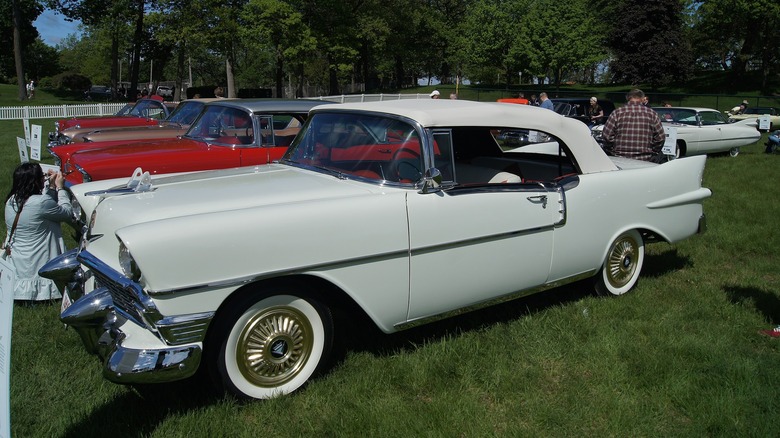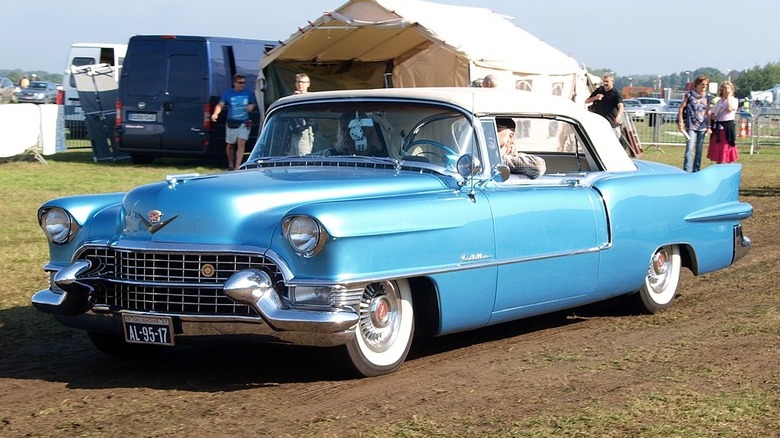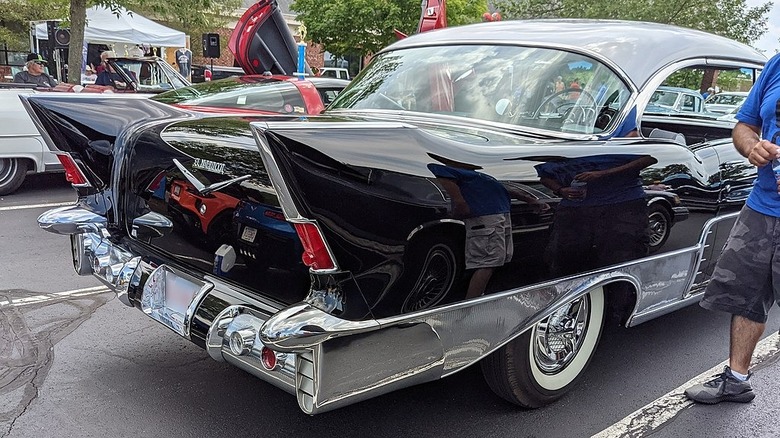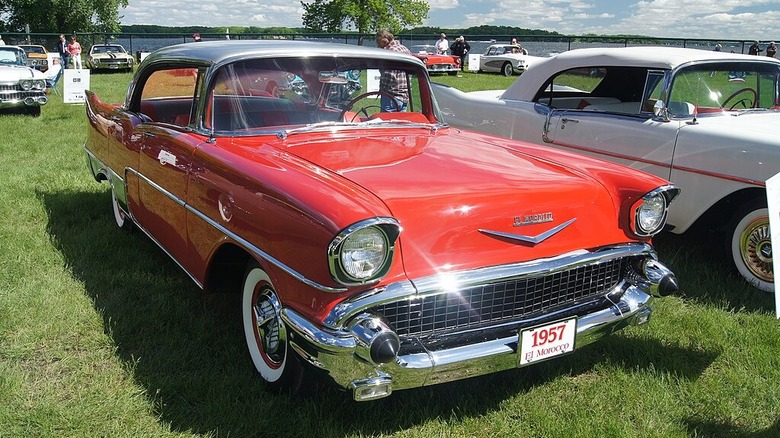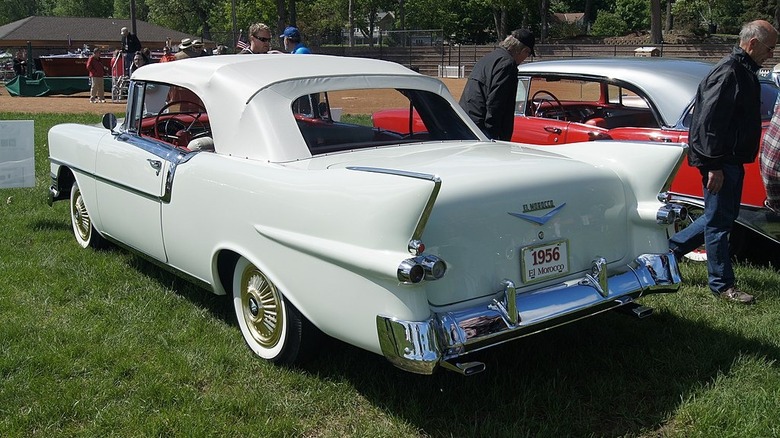What's So Special About The Chevrolet El Morocco?
We can't blame you if you've never heard of the Chevrolet El Morocco. It came out a very long time ago — the mid-1950s, to be exact, and fewer than three dozen were built. Lastly, it wasn't so much a true blue "Chevrolet" as a knockoff reusing Chevy cars and made to look like a Cadillac. But the story behind the "Poor Man's Cadillac" is certainly worth knowing.
There wouldn't even be an El Morocco, or a story, without Canadian businessman Reuben "Ruby" Allender, who moved to Detroit from Hamilton, Ontario, in 1913, during the heady days of the automobile's explosive popularity, and just as Detroit was starting to become known as the one and only Motor City.
Allender made his fortune by turning surplus goods into hard cash. For instance, at the end of World War, he purchased tens of thousands of parachutes at a bargain price with the idea of unwinding them and selling off the string as a fishing line. However, on the advice of an employee, he instead called the company that originally made the chutes and sold them back for less than it would have cost to make them from scratch, turning a tidy profit in the process.
He did something similar with unused WWI Red Cross bandages; this time, he needed help storing several train cars full of product. So, Allender approached warehouse owners with an offer to become a partner in that operation if they helped him store the bandages.
[Featured image by Greg Gjerdingen via Wikimedia Commons | Cropped and scaled | CC BY-SA 2.0]
Allender wanted to go big for the little guy
This entrepreneurial spirit would drive Allender to do what others might consider preposterous. The employee who suggested he call the parachute company and sell them back their own product? As a thank you, Allender gave him the car of his choice, which, in this case happened to be a Cadillac. As it turns out, this may have been the very event that first put the idea of selling Cadillacs to blue-collar workers into his head, but he wouldn't act on it for decades.
When Chevrolet rolled out its newly redesigned 1955 model, not only did it sport the first new small-block V8 engine since 1912 (one that powered some of Chevrolet's coolest vehicles), but its styling dripped with elegance making it look strikingly similar to a Cadillac. When Allender saw it, he knew the time had come to sell Caddys to Average Joe's.
He already had all the surplus parts anyone could ever want stashed in his many warehouses. Over the years, he had secured contracts all over Detroit with dealers to purchase convertibles at discounted prices. Now, all he needed was a designer and a prototype.
Allender went to Creative Industries, the independent firm responsible for both the Packard Panther and Ford Atmos. That's where he met Cyril Olbrich. Allender quickly made Olbrich his lead production engineer, and the pair began working on a prototype using fiberglass, lead filling, and of course, the plethora of spare parts from his warehouses.
[Featured image by Alfvanbeem via Wikimedia Commons | Cropped and scaled | CC BY-SA 1.0]
The El Morocco was really just a hodge podge of parts
For all practical purposes, Allender wanted to design a Chevy "Bel Air Brougham," a high-end automobile using a Chevrolet base to make it look like a 1955 Cadillac Eldorado Brougham (one of the best Cadillacs of all time), especially where the rear fins were concerned. Wanting to keep it classy, Allender called his new car "El Morocco," based on the swanky nightclub in Manhattan. He aimed to build ten a day at his three-story warehouse in Detroit.
Allender & Company brochures from 1957 claim the "Chevrolet base" used to make the El Morocco's were always Bel Airs, but it's also rumored 210s were used for the hardtop versions, while Bel Airs were used for the convertibles. Still, others claim the two-door hardtop and convertible were Bel Airs.
Whatever the case, they took those Chevys and stripped off all the exterior molding, including all Chevrolet badging. They then cut off the taillights and added fiberglass tail fins using epoxy bonding. Different parts were collected from other vehicles to make it look "custom."
For example, the Dagmar bumpers were made by taking the headlamps from a 1937 Dodge pickup and simply turning them around. The stylized "V" on the hood was Chevy, but the gold badge above the "V" was a Kaiser horn button. The hubcaps came from a J.C. Whitney catalog. The grills on the '57 version were custom-made from stainless steel, but the rear taillamps were surplus Dodge lenses. Paint schemes replicated those available on the Cadillac Eldorado.
[Featured image by Mike1291 via Wikimedia Commons | Cropped and scaled | CC BY-SA 4.0]
Allender fooled Chevrolet -- briefly
Despite all the time and effort Allender put into changing the outward appearance of the base Chevys he used, he all but ignored ("barely touched" were the exact words used by Motor Trend) their original interior, leaving them virtually unchanged.
The 1956 models were equipped with an OHV 265 cubic inch V8 engine producing 205 hp and went from zero to 60 mph in 10.7 seconds, with a quarter mile time of 18.3 seconds at 76 mph. The car weighed about 3,800 pounds. The '57 model had a bigger OHV 283.0 cubic inch V8 that kicked out a smidge more horsepower at 200, and as such, went from zero to 60 in 9.9 seconds and zipped down the quarter mile in 17.5 seconds at 77.5 mph. They came with Powerglide automatic transmission, power steering, power brakes, a push-button radio, and wider whitewall tires.
Even though Allender legally replaced the Chevrolet manufacturer's name with his El Morocco brand on the registration for every car he built, local Chevy dealers still let him sell the car on their lots ... complete with full factory-warranty. Some of the cars even came with dealer-installed options, which was highly unusual.
[Featured image by Greg Gjerdingen via Wikimedia Commons | Cropped and scaled | CC BY-SA 2.0]
High-end luxury that really was priced for the Average Joe
Allender always wanted to sell what was, in effect, a "poor man's Cadillac." In 1956, a complete El Morocco sold for $3250, just $807 more than a stock Bel Air convertible. A 1957 Allender & Company brochure listed the price for a two-door El Morocco Brougham hardtop at $3125, the four-door at $3175, and the convertible at $3275. Meanwhile, the base price for a 1957 Cadillac spanned a wide range. A Series 62 sedan would only set you back $4713, but the Eldorado Brougham (one of the most luxurious classic American cars of all time) cost an astounding $13,074.
Allender wanted to build ten El Moroccos a day but, in reality, never came close. No more than 34 total were built between the two years of production. Some sources state that 20 were made in all of '56 and only 14 in '57. However, Marv Seisel (a well-known and knowledgeable collector of El Moroccos who personally owns three) was interviewed by Motor Trend and claimed to have spoken directly with Cyril Olbrich, who told him 16 were built in '56 and another 18 in 1957, but that he never worked on the '57 model.
No additional El Moroccos were made. Allender's grandson told Motor Trend that his grandfather ran out of money, and even though Chevy initially allowed him to sell his cars on their lots, it's believed they ended the relationship, making it impossible to sell any more cars, especially in light of the weak demand.
[Featured image by Greg Gjerdingen via Wikimedia Commons | Cropped and scaled | CC BY-SA 2.0]
